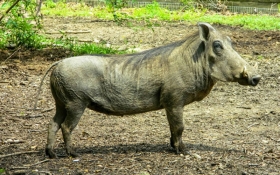
Warthog
Phacochoerus africanus
Animal Behavior: Common warthogs live in family groups called soundings. A sounding usually consists of females and their young. Males usually disperse after 2 years of age and become solitary or form bachelor groups. Females stay in a sounding except when they are pregnant. Soundings can consist of up to 18 members. Common warthogs are primarily diurnal and take refuge at night in burrows. Warthogs commonly utilize aardvark holes for sleeping at night. They cope with high temperatures by wallowing in mud or water and cope with low temperatures by sheltering in burrows and huddling together. They are primarily diurnal when there is not human disturbance.
Eating Habits: Common warthogs are primarily grazers but also feed on roots, berries, bark of young trees, and occasionally carrion. They are specialized for grazing short grasses by being able to lower themselves close to the ground on their wrist joints, which are calloused and padded. Common warthogs use their snouts and tusks to excavate rhizomes and bulbs. Rhizomes and bulbs may also provide water for common warthogs during periods of drought. Common warthogs eat their own dung and the dung of rhinoceroses, African buffalos, waterbucks, and francolins.
Range: Common warthogs are found in open and wooded savannas, grass-steppes, and semi-deserts in Africa. Common warthogs prefer open areas and avoid rainforest and severe desert. They are found on Kilimanjaro up to an elevation of 3000 m and along coastal regions of Africa. Common warthogs often utilize formerly wooded areas that have been cleared for pastures.
Conservation Efforts: Currently common warthogs are not a protected species, but many populations are in serious decline due to overhunting in unprotected areas. Wildlife reserves are trying to protect warthogs, but outside of these areas there are no regulations on hunting. Several zoos have tried captive breeding with very little success.
Animal Facts: Common warthogs weigh 50 to 150 kg with females being 15 to 20 percent lighter than males. Head and body length is 900 to 1500 mm. Shoulder height ranges from 635 to 850 mm. Common warthogs have large upper tusks that are 255 to 635 mm long in males and 152 to 255 mm long in females. As their name suggests, warthogs have three pairs of facial warts, comprised of cartilaginous connective tissue. The three types of warts are: 1) the suborbital warts, which may grow as long as 15 cm in males 2) the preorbital warts, which do not develop as much in females and 3) the submaxillary warts, which have white bristles.
